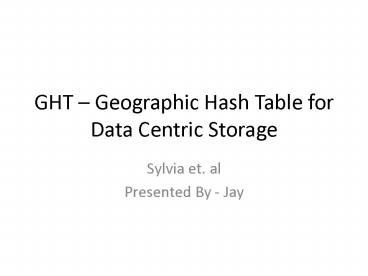GHT Geographic Hash Table for Data Centric Storage
1 / 35
Title:
GHT Geographic Hash Table for Data Centric Storage
Description:
GHT Geographic Hash Table for Data Centric Storage. Sylvia et. al. Presented By - Jay ... Geographic boundaries are known. Nodes know their locations. Access Points ... –
Number of Views:313
Avg rating:3.0/5.0
Title: GHT Geographic Hash Table for Data Centric Storage
1
GHT Geographic Hash Table for Data Centric
Storage
- Sylvia et. al
- Presented By - Jay
2
Concepts
- Data Centric Stroage
- Data are named and communication abstractions
refer to these names rather than to node network
addresses. - Hash Table
- Distribute evenly and provide fast lookup.
- Geographic Hash Table
- Distribute over geography
3
Assumptions
- Large scale
- Geographic boundaries are known
- Nodes know their locations
- Access Points
- Minimize Energy Consumption
- Total Usage
- Hot Spot Usage
4
Sensor Net Data
- Observations
- Low level readings
- Events
- Derived from individual readings
- Tasks
- Users specified instructions
- Actions
- Taken after event occurence
- Queries
- Retrieve information from network
5
Data Dissemination
- Communication Costs
- Message Transmission for floods
- O(n)
- Point to Point Routing
- O(vn)
6
Canonical Methods
- External Storage
- Relevant data sent to central storage
- Costs O(vn) for each event
- No cost for user queries
- Local Storage
- Data stored locally, queries flood.
- Costs O(n) for queries
- Response costs O(vn)
7
Canonical Methods
- Data Centric Storage
- Store event by name, query by name
- O(vn) to store
- O(vn) to query
- O(vn) to return
8
Approximate Communication Costs
- n nodes
- T event types
- Dtotal total no of events detected
- Q no of event types for which queries are
issued - Dq no of events detected for the types of
events queried for.
9
Cost
- External
- Total Dtotal ( vn)
- Hotspot Dtotal
- Local
- Total Q n Dq (vn
- Hotspot Q Dq
10
Data Centric Stroage
- Total
- List
- Q ( vn) Dtotal (vn) Dq (vn)
- Summary
- Q ( vn) Dtotal (vn) Q (vn)
- Hotspot
- List
- Q Dq (list)
- Summary
- 2 Q
11
Important Points
- As n get large, local storage incurs the highest
packet count - ES incurs a lower total message count but not by
much - If Dq gtgt Q and events are summarized, DCS has
lowest load on ACCESS PATH - If events are listed and Dtotal gtgt Dq than DCS
and LS have lower access loads than external
storage.
12
Where to Use DCS
- Sensor networks are large
- There are many detected events but not all are
queried.
13
Design Criteria
- Node Failures
- Topology Changes
- Scalability
- Energy Constraints
14
Goals
- Persistence A (k, v) pair persists
- Consistency query to be routed to the correct
(k,v) node - Scalability Concentration of storage should be
avoided
15
GHT
- Put()
- Get()
- Key k to a location k. Node nearest to k stores
the (k,v) - PRP Perimeter Refresh Protocol
- SR Structured Replication
16
GPSR
- Greedy Perimeter State Routing
- Greedy
- P
- erimeter
17
Greedy
18
Greedy Problem
19
Perimeter
20
Home Node and Home Perimeter
- Home Node
- Node closest to the geographic location.
- Home Perimeter
- The perimeter enclosing the location.
- What happens in case of mobility and failures.
21
Permiter Refresh Protocol
- Stores a copy of a key-value pair at each node on
the home perimeter. - Replica nodes.
- Th seconds, home node generates a refresh packet.
- Take over time , Tt runs at replicas.
- Td, death timer.
- In GHT, Td 3 Th and Tt 2 Th
22
PRP
23
PRP
24
PRP
25
Structured Replication
- Augment event name with hierarchy depth
- Given root r and given hierarchy depth d
- 4d 1
- Storage costs lower from
- O(v n) to O(v n/ 2d)
- Query costs go up
- O(v n) to O(2d v n)
26
Simulation
- Ns2
- 802.11 MAC
- 40 m lt 250m
27
Sim Results
28
SR
29
SR
30
Comparative Study
- n no of nodes
- T no of Event types
- Q no. of event types
- Di no of detected events of type i
31
(No Transcript)
32
(No Transcript)
33
(No Transcript)
34
(No Transcript)
35
Conclusion and Future Work
- Sounds good
- Effect of varying node density as DHT distributes
by location - Boundary knowledge to avoid hashing outside the
boundary































